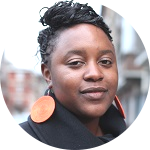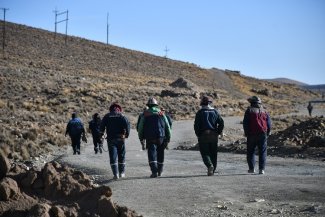Last week, Equal Times published the Count Us In! Women leading change special report. Featuring case studies and interviews with women trade unionists from Angola to Indonesia, Brazil to Ukraine and Tunisia to Spain, it not only explores why female leadership is so important for the trade union movement but also what steps have been taken to ensure a better gender balance in decision-making positions, while highlighting some of the inspiring examples from around the world.
However, the report also takes a look at some of the barriers that prevent women from fully participating in and leading trade unions, from care responsibilities to discrimination to the lack of infrastructure. The report also examines the impact that the International Trade Union Confederation’s (ITUC) four-year Count Us In! campaign has had on the leadership landscape.
This Q&A features previously published, and unpublished, excerpts from some of the interviews that were featured in the report. The answers have been edited for brevity and clarity.
CUT Brazil is one of the few national centres that is actively working to achieve gender parity at all levels, from the membership to leadership. What are some of the challenges CUT is facing, and how will gender parity help build workers’ power?
[Answer from Junéia Martins Batista, national secretary for women workers, CUT Brazil]
As far as I know, CUT is the only national trade union that has gender parity [in its decision-making bodies at a national and state level] but it was not a simple process. When CUT was founded in 1983, out of 30 leaders, only two were women.
So, the women began to organise themselves. It has been a long journey but currently there are eight women that are presidents of CUT [at a state level], most of them rural education workers [Editor’s note: there is also a female vice-president (Carmen Helena Ferreira Foro) and a female deputy secretary-general (Maria Aparecida Faria) at a national level]. The challenge now is to maintain that number of women and maintain the spaces that we have already won. But sometimes I feel that women cannot access positions of power because there are women who don’t work to empower other women. At the national level, what women do not yet have is a spirit of body. By this I mean that us women need to understand that it is necessary to have unity in action.
The Australian Council of Trade Unions (ACTU) has enjoyed over two decades of women leaders, including the current Executive which has women in the two most senior posts. How was this achieved and what lessons can you share with other trade unions hoping to replicate your success?
[Sally McManus, secretary of the ACTU]
Women from the Australian union movement have also been at the forefront of the women’s movement in our country for nearly a century. It has been union women that have driven society-wide change. This means that our movement is full of strong feminist women who have organised and pushed for change. The rules of the ACTU guarantee equal representation at our executive, and where women are missing from any forum, this will always be commented on and criticised. All of this has been part of achieving equality in decision-making. Mandating equality via rules has been essential to overcoming historical disadvantage, unconscious biases and political considerations which have been barriers to equality. Once women began to occupy senior roles in our movement, it became normalised. The challenge becomes spreading this to all parts of our movement, especially in industries which are highly gender segregated, and changing the expectations of leadership which often make it hard for women (or men) with young children or other family members they care for to perform both these roles.
What is the general situation for women in Angola and what role are the unions playing to improve it?
[Maria Fernanda Carvalho Francisco, assistant general secretary of UNTA-CS Angola and the deputy president of the ITUC]
Until recently, the issue of gender equality was considered to be an issue for women only, but gradually it is becoming a concern for society as a whole. Today we have more women going to university and an even greater number of women in the labour market. But we are still recovering from decades and decades of colonialism.
We had many years of an unprecedented and pointless war. Also, Angola is one of the countries which has suffered greatly from the [most recent] oil crisis and, therefore, the economic and social situation is quite bad, but particularly for women. For example, our minimum wage covers less than 20 per cent of our basic food basket. And since, because of the war, many women are the heads of their families, they are in a very difficult situation. A woman who is the head of her household and lives on a minimum wage, or works in the informal sector not making even a minimum wage – those women are not living, they are surviving. And they survive with all the external and internal misogynistic factors that do not allow them to have a better position in our society. But we are working to overcome this by strengthening our union actions to demand better conditions for all workers, but women workers in particular.
Tunisia is held up as a shining example for the progress than can be made towards women’s rights in the Middle East/North Africa region, but what still needs to be done?
[Sihem Boussetta, the deputy general secretary in charge of training and international relations at the Tunisian General Labour Union, UGTT, and a member of the ITUC Women’s Committee]
The trade union movement was decisive in preserving the gains of Tunisian women, which were being threatened by conservative and religious parties after the [2011] revolution. Through its collaboration with the civil society, UGTT supported protests, sit-ins and demonstrations leaded by Tunisian women, with a fierce determination to safeguard their rights.
However, the situation of Tunisian women remains unsatisfying. There are twice as many women unemployed as there are men. Only 34.5 per cent are covered by social security, only 38.5 per cent receive a pension and only 50 per cent have a health insurance. The situation is even more appalling in the rural areas, where only 11 per cent of women are beneficiaries of social security. Women employed in the informal sector are most vulnerable to all kind of precarity, hardship and marginalisation. Also, the degree of participation of women in national, regional and local decision-making authorities remains weak. We are still very far from the parity advocated by the Tunisian constitution.
The leadership of the Canadian Labour Congress (CLC) is one of the most diverse in the international trade union movement. How has this been received?
[Marie Clarke Walker, secretary-treasurer, CLC]
There is still hesitation within the Canadian labour movement with respect to women, with respect to women of colour, with respect to dealing with all of our intersections. The movement is still very much male-dominated, however, in 2002 when I was first elected [as executive vice-president, becoming the first racialised woman and youngest person to hold the position] it was basically the women who got together and said: ‘Enough is enough’. In 2001, we held a women’s retreat that looked at how to change the culture and structure of the movement so that it was more reflective of the working people of this country. And my election in 2002 was the outcome of that. But what we did not look at was how do we really deal with intersectionality? How do we ensure that more women that are not white and not straight, for example, get into positions of leadership?
And while the movement has offered courses and training, I don’t think that’s what changes people’s minds. Based on the women that I know and the women that I have talked to, actually seeing someone in a leadership position who looks like them or comes from the same background as them, helps them believe that they can do the same thing. But we still don’t have enough diverse women in leadership positions because there is still a backlash when people in top positions don’t fit a certain prototype. I’ve heard people say: ‘I am a white male. I will never get elected or re-elected’ but that’s not how this works. People elect the people who best represent their interests, who share their goals and objectives. Bringing people in doesn’t mean pushing other people out. In fact, when more people feel included they actually get involved. And when you have that critical mass, it is a lot easier to make demands. It’s a lot easier to build a movement.
How serious is the situation of gender-based violence in Spain and what are unions doing in this regard?
[Elena Blasco Martín, secretary for women and equality at CCOO, Spain]
Despite the fact that our constitution proclaims the right to life and equality, and our legislation offers protection against sexist violence and mechanisms to punish it, gender-based violence is present in our society, year after year, without any improvement or progress in its eradication. For example, in 2017, 51 women were killed [as a result of gender-based violence in Spain] and as of September this year, 33 women were killed. Historically, this violence has been strongly opposed by trade unions and progressive leftist political parties, with complaints and demonstrations taking place on occasions such as 25 November [the International Day for the Elimination of Violence Against Women] and events such as Spain’s first-ever Women’s Strike on 8 March 2017 [which marks International Women’s Day], where CCOO and UGT called for partial work stoppages to denounce sexist violence and structural inequality. We demand the necessary budget for the implementation of the State Pact on Gender Violence [which offers a fairly comprehensive outline on how to tackle gender-based violence and was approved in September 2017 but has since been idle due to the government’s failure to secure a budget for the law]. We also demand absolute transparency in the application of financing in order to effectively guarantee the application of the measures committed.











